Amish Shortcake Recipe: Looking for a dessert that’s simple, comforting, and timeless? This Amish Shortcake Recipe brings old-fashioned bakery flavor to your kitchen with pantry staples and straightforward steps. It’s the kind of made-from-scratch treat that feels special without being fussy.
What sets this shortcake apart is its tender, biscuit-like crumb and lightly sweet flavor, perfect for soaking up fresh fruit juices. The Amish Shortcake Recipe typically bakes as a single slab you split and layer, making it sturdy enough for juicy strawberries yet soft enough to melt into a cloud of whipped cream.
Whether you’re hosting a summer get-together or craving a cozy weeknight dessert, this Amish Shortcake Recipe is endlessly adaptable. Top it with macerated berries, sliced peaches, or a spoon of homemade jam, and finish with whipped cream or a drizzle of vanilla custard. Simple ingredients, memorable results.
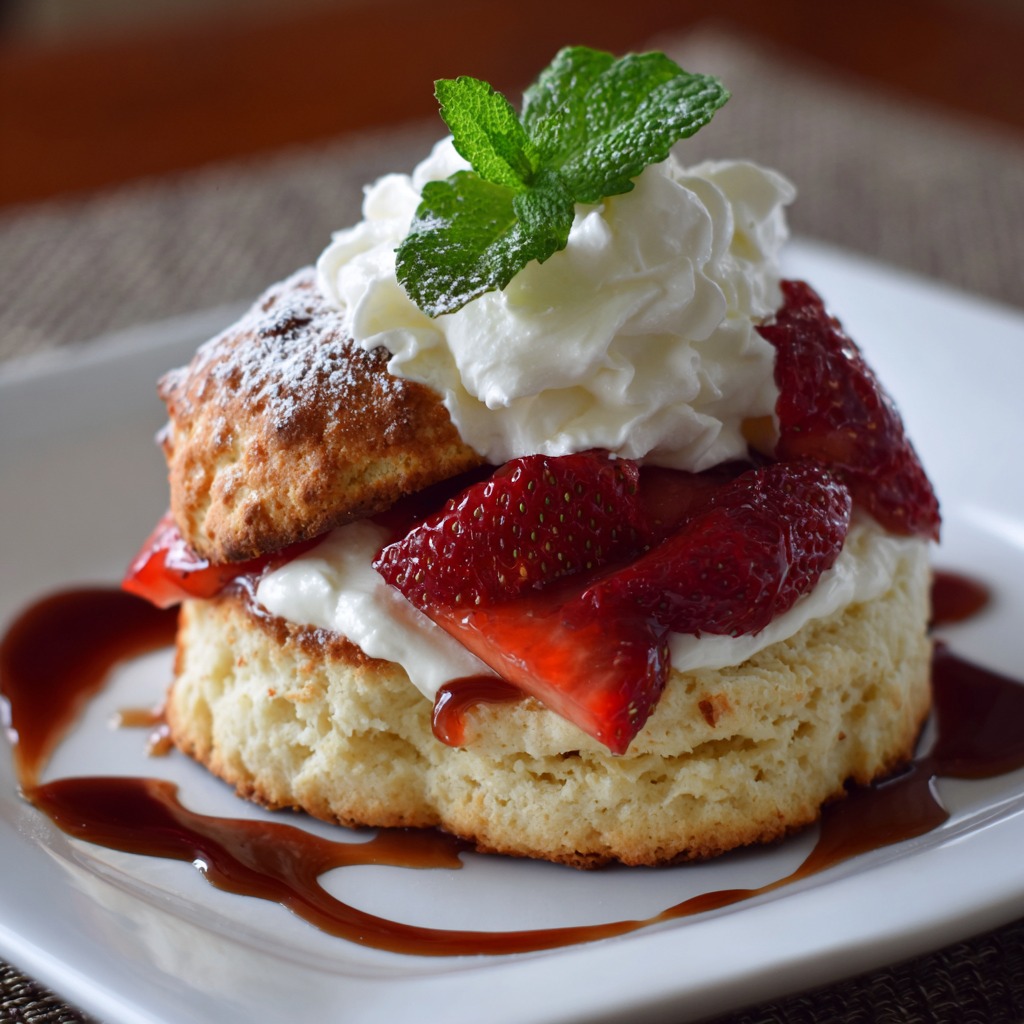
- What Makes This Amish Shortcake Recipe Unique
- Why You’ll Love This Amish Shortcake Recipe
- Ingredient Spotlight
- Tools & Timing
- Step-by-Step: From Mixing Bowl to Golden Slab
- Pro Tips for Bakery-Style Results
- Classic Strawberry Topping (Plus Fruit Ideas)
- Make-Ahead, Storage & Freezing
- Common Mistakes & Easy Fixes
- Variations & Dietary Swaps
- Serving Ideas for Any Season
- Exact Measurements for a Classic Amish Shortcake Recipe (8–9 inch pan)
- Golden Rules for Tender, Biscuit-Style Shortcake
- Fruit Prep & Sweetness Guide (Choose-Your-Fruit)
- Whipped Cream Three Ways
- Pan Choices & Bake Time Adjustments
- Scaling the Amish Shortcake Recipe for a Crowd
- Make-Ahead, Day-Of Game Plan
- High-Altitude & Humidity Tweaks
- Flavor Variations (Still Classic at Heart)
- Savory Spin (Shortcake for Brunch)
- Serving & Plating Ideas That Pop
- Troubleshooting Fast Fixes
- Storage, Reheating & Freezing
- Nutrition & Allergen Notes (Approx.)
- ngredient Substitutions & Why They Work
- Buttermilk vs. Milk: What Changes in Texture
- The Science of Tender Shortcake
- Step-by-Step Visual Cues You Can Trust
- Gluten-Free Amish Shortcake (Tested)
- Dairy-Free or Vegan Variation
- Sugar Choices & Sweetness Control
- Serving Size, Yield & Scaling
- Kid-Friendly Helper Tasks
- Shortcake vs. Sponge vs. Scone—What’s Different
- Simple Cost & Pantry Planner
- Food Safety & Make-Ahead Timing
- Seasonal Shortcake Guide
- Texture Troubleshooting—Deep Dive
- Presentation Ideas for Wow Factor
- Quick Checklist Before You Bake
- Conclusion
What Makes This Amish Shortcake Recipe Unique
This shortcake leans biscuit-style rather than sponge: lightly sweet, sturdy enough to split, and perfect at soaking up berry juices without turning soggy. Traditional Amish baking favors pantry staples, minimal fuss, and dependable texture, so you get a golden top, a tender crumb inside, and flavors that shine with simple fruit and cream.
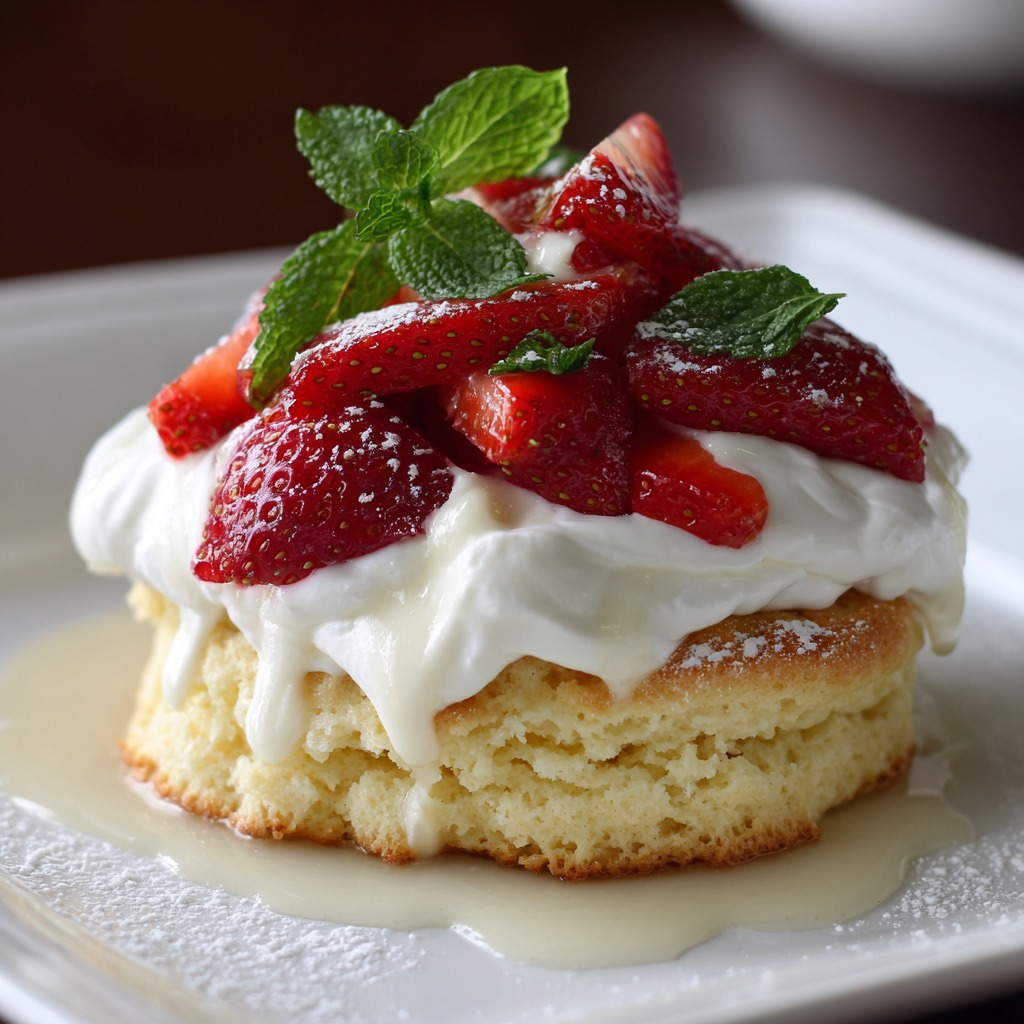
Why You’ll Love This Amish Shortcake Recipe
It’s fast, forgiving, and endlessly adaptable. The dough comes together in minutes, bakes as a single slab or in rounds, and slices cleanly for neat layers. It’s just sweet enough to pair with macerated strawberries, peaches, or jam; meaning you can shift from summer picnics to cozy winter desserts with zero drama.
Ingredient Spotlight
Flour provides structure while a generous lift (baking powder) keeps the crumb light. Cold butter or shortening delivers flakiness; a touch of sugar tenderizes without making it cake-sweet. Milk or buttermilk adds moisture and subtle tang. A pinch of salt sharpens every flavor, especially alongside fresh fruit.
Tools & Timing
You’ll need a mixing bowl, pastry cutter (or two forks), a baking pan (8–9 inch square for a slab, or a sheet for rounds), and a cooling rack. From bowl to table, plan about 35–45 minutes: 10 minutes to mix, 20–25 minutes to bake, 5–10 minutes to cool and split.
Step-by-Step: From Mixing Bowl to Golden Slab
Cut cold fat into the dry mix until sandy with pea-sized bits; add milk just until the dough holds. Pat into the pan; no overworking. Bake until the top is lightly browned and a tester comes out clean. Cool briefly, split horizontally, and layer with juicy fruit and softly whipped cream so the crumb absorbs flavor without collapsing.
Pro Tips for Bakery-Style Results
Work fast with cold ingredients for better lift. Don’t knead, gentle handling keeps it tender. If using buttermilk, reduce sugar slightly; the tang enhances fruit. Brush the top with milk before baking for shine. For ultra-flaky layers, chill the shaped dough for 10 minutes before it goes into the oven.
Classic Strawberry Topping (Plus Fruit Ideas)
Toss sliced strawberries with sugar and a squeeze of lemon; rest 15–30 minutes to draw out syrupy juices. In spring, try rhubarb compote; i n summer, peaches or blueberries; in fall, cinnamon-spiced apples; in winter, warmed jam or preserved cherries. Always add fruit (and its juices) just before serving for the best texture.
Make-Ahead, Storage & Freezing
Bake the shortcake a day ahead and keep tightly wrapped at room temp. Split and assemble right before serving to preserve crumb. Leftovers hold 1–2 days in the fridge; rewarm briefly to refresh. The baked slab freezes well (up to 2 months); thaw wrapped, then crisp in a low oven for 5–8 minutes.
Common Mistakes & Easy Fixes
Dense texture? You likely overmixed or used warm butter. Crumbly and dry? Added too much flour; next time measure by weight or fluff-scoop-level. Pale top? Bake a few minutes longer and place the pan higher in the oven. Soggy base? Cool longer and add fruit right before serving.
Variations & Dietary Swaps
| Variation | What to change | Amount | Quick effect |
|---|---|---|---|
| 50/50 Butter–Shortening | Replace half the butter with shortening | 3 Tbsp butter + 3 Tbsp shortening | Taller, flakier crumb |
| Buttermilk | Use instead of milk | 3/4 cup (add 1–2 Tbsp if dry) | Softer, subtle tang |
| Low-Sugar Dough | Reduce sugar | 2 Tbsp (25 g) | Lets fruit shine |
| Cornmeal Crunch | Swap some flour | 1/2 cup (60 g) cornmeal | Gentle crunch, rustic |
| Whole-Wheat Half | Replace half the flour | 1 cup white WW + 1 cup AP; +1–2 Tbsp milk | Nuttier, heartier |
| Gluten-Free | Use 1:1 GF blend | 2 cups (280 g) + +1 Tbsp milk; rest 5–8 min | Tender, GF |
| Dairy-Free | Plant butter + non-dairy milk | 6 Tbsp plant butter; 3/4–1 cup milk alt | Classic texture, DF |
| Vegan Cream | Coconut whipped cream | 1 can chilled coconut milk + sugar/vanilla | Rich, dairy-free |
| Lemon–Blueberry | Add zest; use blueberries | 1 tsp lemon zest; 1 lb berries | Bright, aromatic |
| Savory Cheddar–Chive | Cut sugar; add cheese/herbs | 1 Tbsp sugar; 1/2 cup cheddar; 2 Tbsp chives | Brunch-friendly, savory |
Serving Ideas for Any Season
Cut into squares or rounds, split, and stack with fruit and softly whipped cream. Drizzle with vanilla custard or a quick caramel for a richer finish. For gatherings, bake as mini rounds for individual stacks; for family style, serve as a tall layered slab and spoon over extra juices at the table.
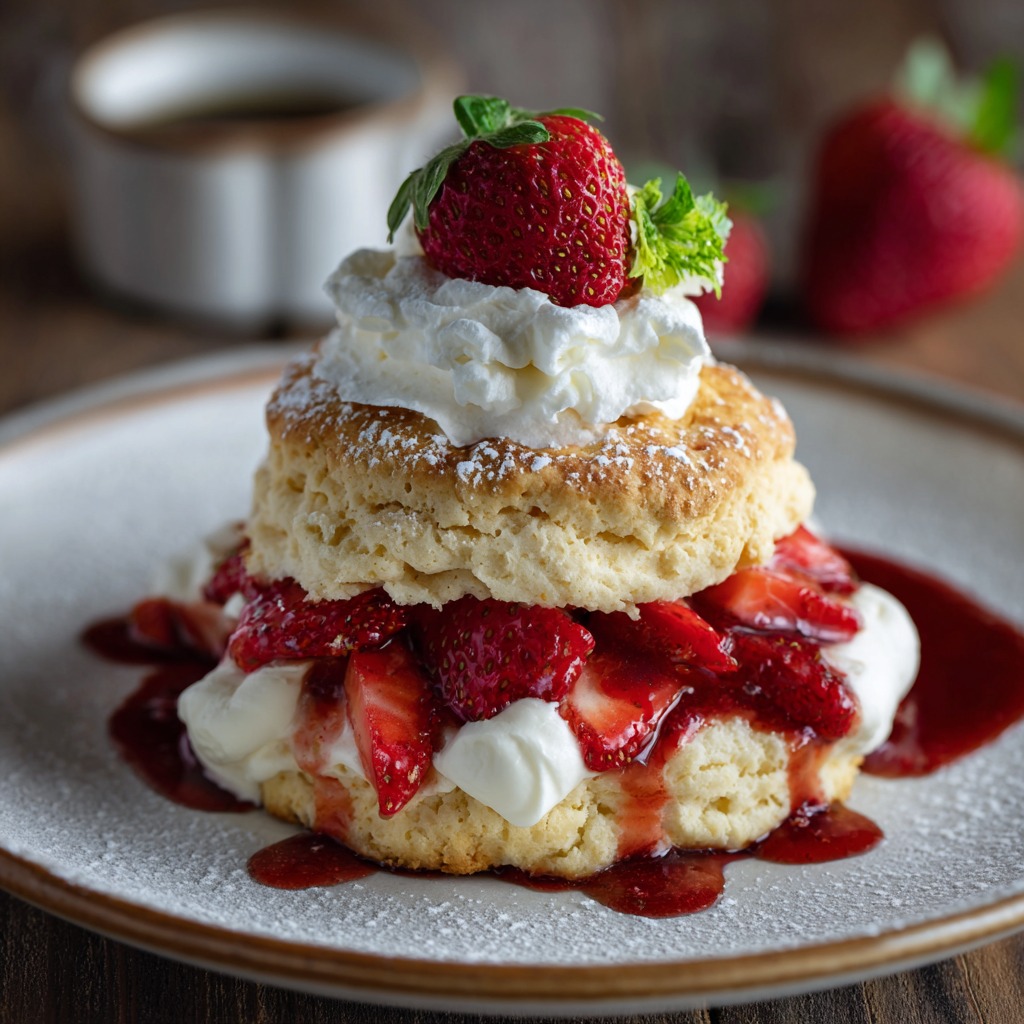
Exact Measurements for a Classic Amish Shortcake Recipe (8–9 inch pan)
Use 2 cups (240 g) all-purpose flour, 1/4 cup (50 g) sugar, 1 Tbsp baking powder, 1/2 tsp fine salt, 6 Tbsp (85 g) cold butter (cubed), and 3/4–1 cup (180–240 ml) milk or buttermilk. Mix dry, cut in butter until sandy with pea-sized bits, stir in 3/4 cup liquid just until a shaggy dough forms (add the last 1/4 cup only if dry). Pat to 3/4–1 inch thick in a greased 8–9 inch pan. Bake at 400°F (205°C) for 20–25 minutes until lightly golden. Cool 10 minutes, split, fill.
Golden Rules for Tender, Biscuit-Style Shortcake
Keep fat and milk cold, handle dough minimally, and avoid kneading. Press, don’t roll, to keep layers intact. Bake hot (400°F/205°C) for lift and a crisp top. Rest 10 minutes before splitting so steam settles and the crumb stays plush.
Fruit Prep & Sweetness Guide (Choose-Your-Fruit)
For 1 lb (450 g) fruit, add 2–4 Tbsp sugar plus a squeeze of lemon and a pinch of salt. Strawberries: 3 Tbsp sugar; peaches: 2 Tbsp; blueberries: 2–3 Tbsp with lemon zest; cherries: 3–4 Tbsp with vanilla. Macerate 15–30 minutes so juices form—those juices are your “sauce.”
Whipped Cream Three Ways
Classic: 1 cup cold heavy cream + 1–2 Tbsp sugar + 1 tsp vanilla, soft peaks. Tangy: fold 1/3 cup sour cream or Greek yogurt into softly whipped cream. Extra-stable: dissolve 1 tsp gelatin in 1 Tbsp water, cool, then stream into whipping cream at soft peaks for slices that hold longer.
Pan Choices & Bake Time Adjustments
Square pan (8–9 inch): bakes as one slab—easy to split and layer. Sheet pan rounds (2.5–3 inch cutters): bake 12–15 minutes; great for individual servings. Cast iron (9–10 inch): superb browning; check at 18–20 minutes. Dark pans brown faster; start checking early.
Scaling the Amish Shortcake Recipe for a Crowd
Double for a 9×13 inch pan (increase bake time to 24–30 minutes). Triple for party trays; mix in two batches to avoid overworking dough. For mini rounds, figure ~1.5 rounds per guest once filled with fruit and cream.
Make-Ahead, Day-Of Game Plan
Day -1: Bake and cool the shortcake, wrap airtight at room temp. Morning of: slice fruit and macerate 30 minutes before service. Just before serving: whip cream, split shortcake, and assemble to keep the crumb from getting soggy.
High-Altitude & Humidity Tweaks
Above 3,000 ft (900 m): reduce baking powder to 2 tsp, increase milk slightly if dough feels dry, and start checking doneness 3–4 minutes earlier. In humid climates, measure flour by weight and keep ingredients chilled to prevent a dense crumb.
Flavor Variations (Still Classic at Heart)
Add 1 tsp vanilla or 1/4 tsp almond extract to the dough for warmth. Swap 1/2 cup (60 g) of flour with fine cornmeal for subtle crunch. Stir in citrus zest (lemon/orange) or a pinch of nutmeg. Sprinkle 1–2 Tbsp coarse sugar on top before baking for a crackly finish.
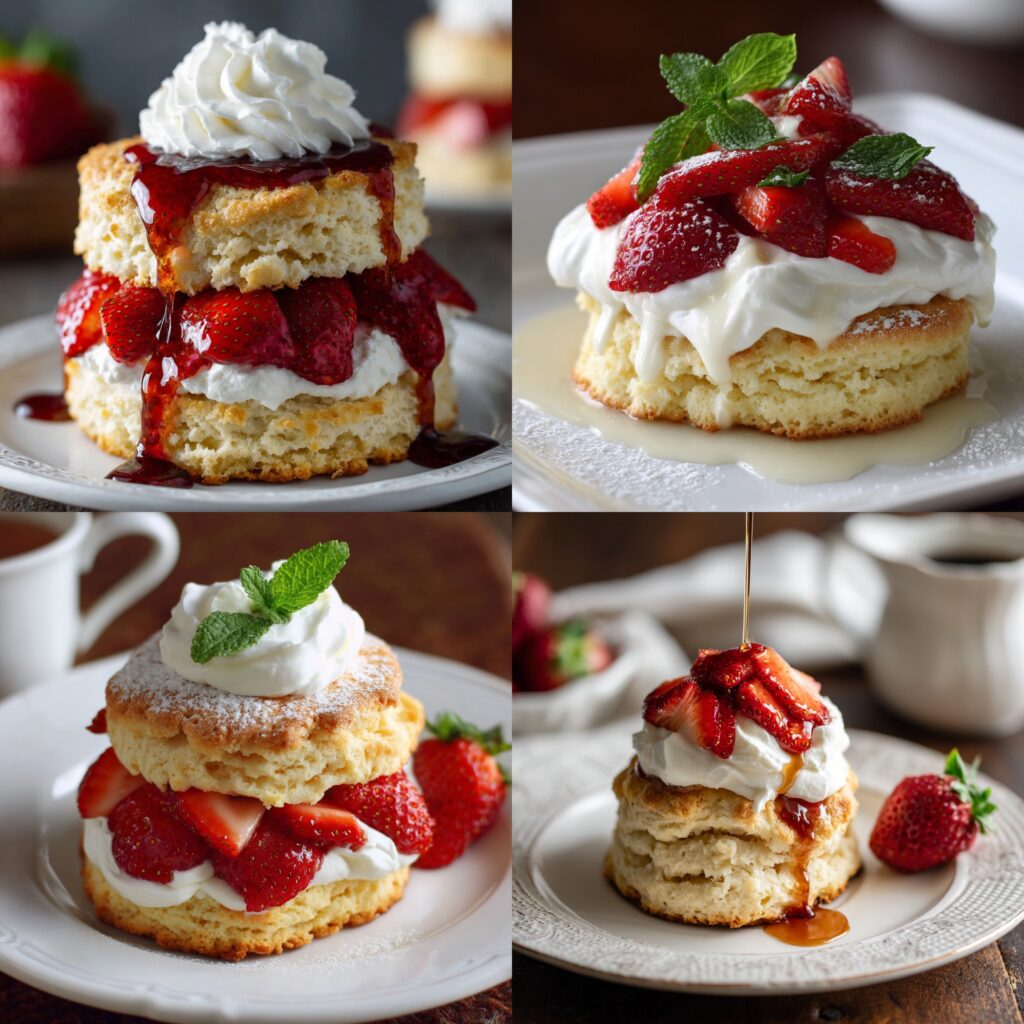
Savory Spin (Shortcake for Brunch)
Cut sugar to 1 Tbsp, add 1/2 cup grated sharp cheddar and 2 Tbsp chopped chives. Serve with sliced tomatoes, salted cucumbers, and a dollop of herbed crème fraîche—proof that the Amish shortcake technique isn’t just for dessert.
Serving & Plating Ideas That Pop
Warm slices stacked with glossy fruit and soft cream look elegant in tall layers. Spoon extra macerating juices over the plate for color. For a buffet, set out bowls of different fruits and a pitcher of cream so guests customize their own stacks.
Troubleshooting Fast Fixes
If the dough is crumbly and won’t come together, mist in 1–2 Tbsp extra milk. If the shortcake bakes pale, move the pan up one rack and add 2–4 minutes. Gummy center? It needed a few more minutes; tent with foil and bake longer next time, and let it rest before slicing.
Storage, Reheating & Freezing
Keep unfilled shortcake wrapped at room temp up to 24 hours. Refrigerate assembled leftovers up to 2 days; re-crisp slices in a 300°F (150°C) oven for 5–8 minutes. Freeze the baked, uncut slab up to 2 months; thaw wrapped and refresh in the oven to revive the crust.
Nutrition & Allergen Notes (Approx.)
A generous 1/8 pan serving (shortcake only) is roughly 280–320 calories depending on butter vs. shortening and milk choice. Contains gluten and dairy; for dairy-free use plant butter and non-dairy milk, and serve with coconut whipped cream.
ngredient Substitutions & Why They Work
Swap up to half the butter with vegetable shortening for extra lift and a more tender crumb—the higher melting point slows fat melt and creates taller layers. No buttermilk? Use milk plus 1 tsp lemon juice or vinegar per cup to mimic acidity and tenderness. Out of granulated sugar? Fine caster sugar dissolves faster and yields a more delicate bite.
Buttermilk vs. Milk: What Changes in Texture
Buttermilk’s acidity weakens gluten and reacts with baking powder for a softer, slightly taller shortcake. Milk gives a cleaner, biscuit-like crumb with a crisper top. If using buttermilk, hold back 1–2 Tbsp to prevent a wet dough; add only if crumbly.
The Science of Tender Shortcake
Tenderness comes from three levers: cold fat (flake), minimal mixing (low gluten), and proper heat (quick steam for lift). Pea-sized fat pockets create micro-layers; overworking smears fat and toughens the crumb. A hot oven (400°F/205°C) sets structure fast so juices won’t sog out the base.
Step-by-Step Visual Cues You Can Trust
After cutting in fat, the mix should look sandy with visible pea bits—no big butter slabs. When you add milk, stop at “shaggy”: clumps that barely hold if squeezed. Baked shortcake is ready when edges are golden, the center springs back, and a toothpick has a few moist crumbs (not wet batter).
Gluten-Free Amish Shortcake (Tested)
Use 2 cups (280 g) of a 1:1 gluten-free blend that contains xanthan gum, plus 1 extra tablespoon of milk. Let the dough rest 5–8 minutes so the starches hydrate before baking. Expect a slightly finer crumb; brush the top with milk for color and crunch.
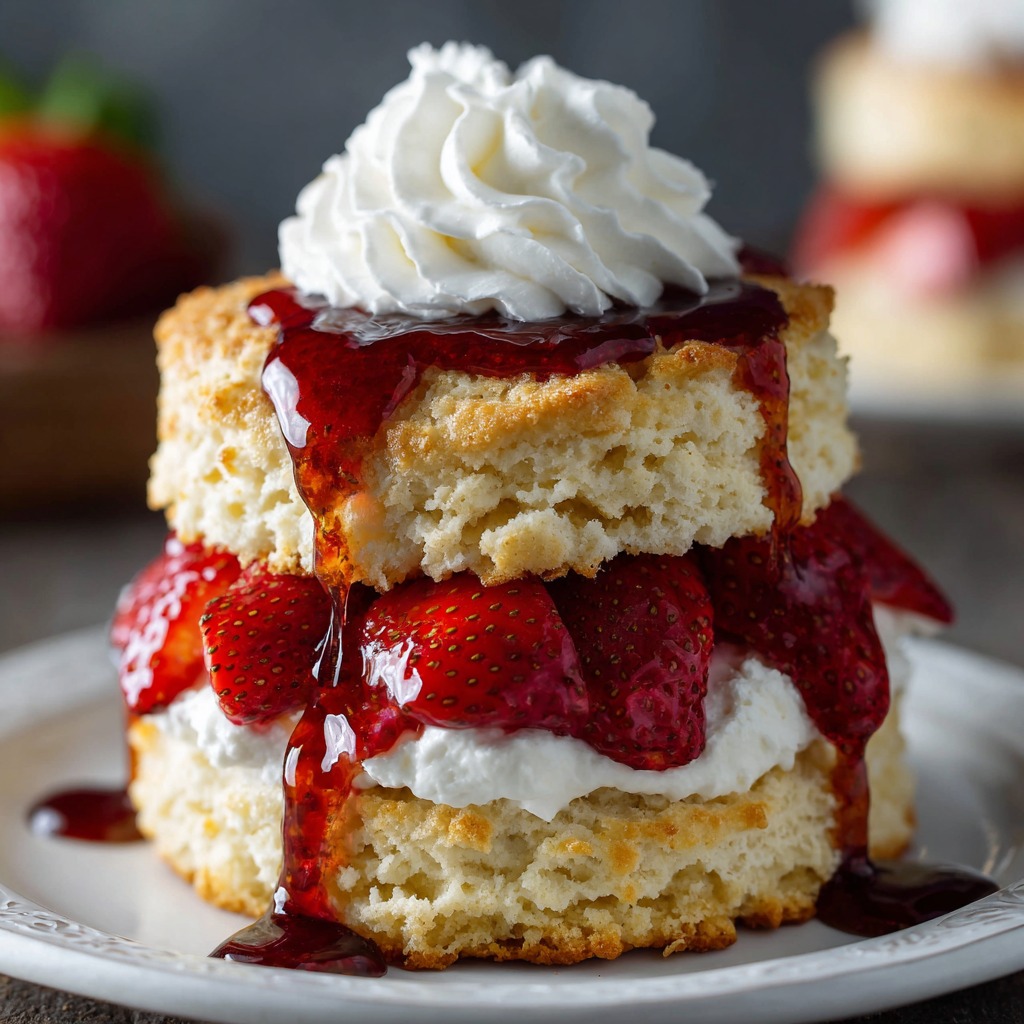
Dairy-Free or Vegan Variation
Replace butter with plant butter sticks (not spread) and use unsweetened almond or oat milk; add 1 tsp vanilla for roundness. For richer flavor, use 50/50 plant butter and refined coconut oil (no coconut aroma). Serve with coconut whipped cream and macerated fruit to keep the classic vibe.
Sugar Choices & Sweetness Control
Granulated sugar keeps flavors clean; turbinado adds light caramel and a crackly top if sprinkled before baking. If your fruit is very sweet, cut dough sugar to 2 Tbsp to keep balance. A teaspoon of honey in the fruit amplifies aroma without making the base too wet.
Oven Type: Conventional vs. Convection
In convection (fan) ovens, reduce temp to 385°F (196°C) and start checking at 16–18 minutes to avoid over-browning. Rotate the pan once for even color. In small toaster ovens, place the rack higher and watch closely; small cavities brown faster.
Flavor Pairings That Never Miss
Lemon zest in the dough + blueberries = bright and classic. Almond extract + cherries gives bake-shop nostalgia. Vanilla + peaches sings with a drizzle of cream; nutmeg + strawberries adds warmth without stealing the show.
Serving Size, Yield & Scaling
An 8–9 inch slab serves 8 generous portions once layered with fruit and cream. For a 9×13, double the dough; bake 24–30 minutes. For individual rounds (2.75–3 inch), expect 8–10 pieces; split and fill à la minute for the best texture.
Make It Party-Ready (Assembly Line)
Pre-split the slab and keep layers wrapped. Set out bowls of fruit (with their juices), whipped cream, and a ladle. Guests stack their own, and you avoid sogginess—win-win.
Leftover Transformations
Cube leftover shortcake, layer with fruit and yogurt for breakfast parfaits. Make a quick trifle with pastry cream or vanilla pudding. Toast slices lightly and top with warmed jam for a tea-time treat.
Kid-Friendly Helper Tasks
Kids can wash and slice soft berries, measure dry ingredients, and brush milk on the top before baking. Let them assemble their own stacks—it’s messy in the best way and teaches portioning.
Shortcake vs. Sponge vs. Scone—What’s Different
Shortcake is a biscuit-style dough with cold fat and chemical leaveners—meant to be split and soaked. Sponge cake is egg-aerated, sweeter, and springy; it absorbs syrup but lacks the flaky layers. Scones are richer (often eggs/cream) and denser, better for jam than juicy fruit.
Simple Cost & Pantry Planner
The base uses flour, sugar, baking powder, salt, and butter—true pantry staples. Fruit and cream are the only “special” buys. Keep frozen berries on hand and you can whip up dessert any time without a store run.

Food Safety & Make-Ahead Timing
Keep whipped cream and assembled shortcakes chilled if not serving within 1 hour. For parties, store fruit in the fridge and drain excess juices right before service; pass juices at the table. Unfilled shortcake keeps best at room temp, tightly wrapped, up to 24 hours.
Seasonal Shortcake Guide
Spring: strawberries + lemon zest. Summer: peaches/nectarines + vanilla. Fall: cinnamon apples + a little caramel. Winter: blood oranges with a touch of honey or warmed cherry preserves.
Texture Troubleshooting—Deep Dive
Cracks on top? Dough likely a touch dry—next time add 1–2 tsp more milk. Greasy bottom? Butter was too warm or pan over-greased; chill 10 minutes before baking. Tight crumb? You overmixed; aim for barely combined with visible streaks of flour that disappear as you pat it in.
Presentation Ideas for Wow Factor
Cut clean squares, stack with offset layers so fruit peeks out, and spoon glossy juices over the plate. Finish with a light dusting of powdered sugar or a few toasted almond slivers. Serve on chilled plates in summer to keep cream from melting fast.
Quick Checklist Before You Bake
Cold fat? Check. Hot oven preheated? Check. Dough looks shaggy, not smooth? Perfect. Pan greased but not slick? Good. Fruit macerating while the shortcake bakes? You’re on track for bakery-level results.
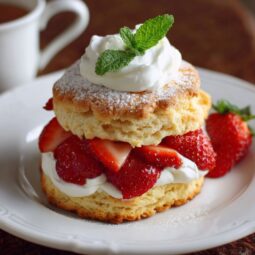
Amish Shortcake Recipe
Equipment
- Mixing bowl, whisk, and spatula
- Pastry cutter or two forks (for cutting in butter)
- 8–9 inch (20–23 cm) square pan or 9–10 inch cast-iron skillet
- Measuring cups/spoons (or a kitchen scale)
- Knife or serrated knife for splitting
- Cooling rack
Ingredients
- Shortcake
- 2 cups 240 g all-purpose flour
- 1/4 cup 50 g sugar
- 1 Tbsp baking powder
- 1/2 tsp fine salt
- 6 Tbsp 85 g cold unsalted butter, cubed
- 3/4 –1 cup 180–240 ml cold milk or buttermilk
- Optional 1 tsp vanilla extract
- Optional finish 1–2 tsp milk + 1 Tbsp coarse sugar for the top
- Fruit & Cream
- 1 lb 450 g strawberries, sliced (or peaches/blueberries/cherries)
- 2 –4 Tbsp sugar to taste + 1 tsp lemon juice + tiny pinch of salt
- 1 cup 240 ml cold heavy cream
- 1 –2 Tbsp sugar + 1 tsp vanilla for the cream
Instructions
- Prep the oven & pan. Heat oven to 400°F / 205°C. Lightly grease the pan.
- Mix dry. In a bowl, whisk flour, sugar, baking powder, and salt.
- Cut in butter. Work in the cold butter with a pastry cutter/forks until the mixture looks sandy with some pea-sized bits.
- Add liquid. Stir in 3/4 cup milk (plus vanilla if using) just until a shaggy dough forms. If dry, add milk 1 Tbsp at a time; do not overmix.
- Pan & bake. Pat dough into the pan 3/4–1 inch thick. Brush with milk and sprinkle coarse sugar if desired. Bake 20–25 minutes until lightly golden and the center springs back. Cool on a rack 10 minutes.
- Fruit & cream. While baking, toss fruit with sugar, lemon, and a pinch of salt; rest 15–30 minutes to draw out juices. Whip cream with sugar and vanilla to soft peaks.
- Assemble. Carefully split the warm shortcake horizontally. Layer bottom with half the fruit (and juices) and some cream, cap with the top, then finish with remaining fruit and dollops of cream. Serve immediately.
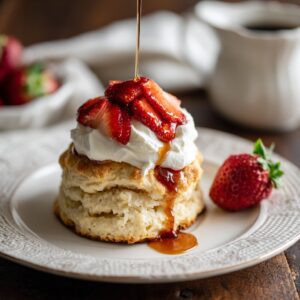
Notes
- Texture keys: Keep butter and milk cold; mix just to combine; bake hot for good lift.
- Buttermilk vs. milk: Buttermilk gives a softer, slightly taller crumb; if using it, you may need 1–2 Tbsp less.
- Gluten-free: Use a 1:1 GF flour blend (with xanthan); add 1 Tbsp extra milk and rest dough 5–8 min before baking.
- Dairy-free: Use plant butter sticks and non-dairy milk; serve with coconut whipped cream.
- Fruit guide: For 1 lb fruit, use 2–4 Tbsp sugar (strawberries ~3 Tbsp; peaches 2 Tbsp; blueberries 2–3 Tbsp with lemon zest).
- Scaling: Double for a 9×13 inch pan; bake 24–30 min. For individual rounds (2.75–3 in), bake 12–15 min.
- Make-ahead: Bake a day ahead; wrap at room temp. Split/assemble right before serving.
- Storage: Unfilled shortcake keeps 24 hrs at room temp; assembled leftovers 1–2 days in the fridge. Refresh slices at 300°F/150°C for 5–8 min.
- Flavor twists: Add lemon zest, a pinch of nutmeg, or swap 1/2 cup flour for fine cornmeal for gentle crunch.
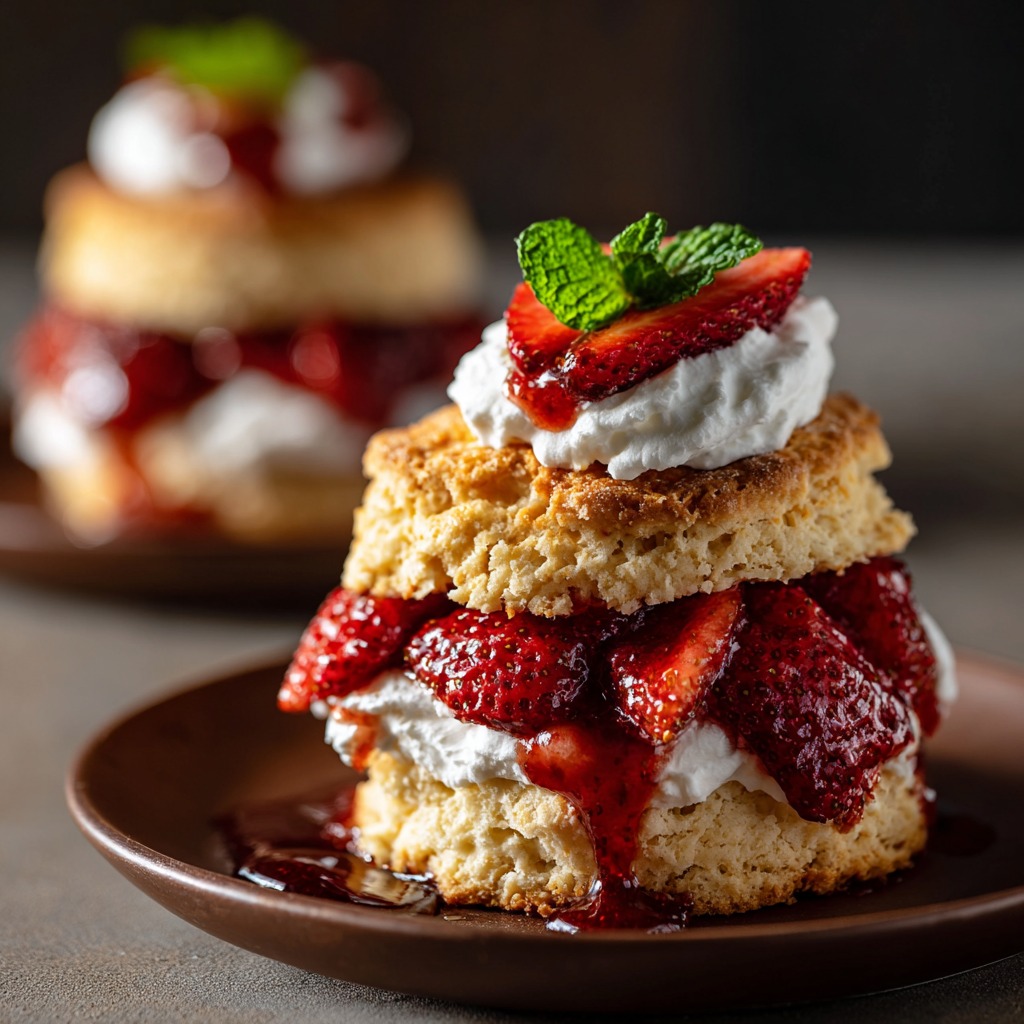
Conclusion
The Amish Shortcake Recipe is proof that simple ingredients and gentle technique can deliver a bakery-worthy dessert any night of the week. With its tender, biscuit-style crumb and lightly sweet flavor, it’s the ideal canvas for seasonal fruit and soft whipped cream, comforting in summer with berries, just as good in winter with warm preserves.
Keep the fat cold, don’t overmix, and bake hot for lift, those are the only real rules. From there, customize the topping, scale it for a crowd, or try gluten-free or dairy-free swaps without losing the classic charm. Bake the slab, split, and serve: this Amish Shortcake Recipe turns pantry staples into a memorable finish every time.
hare Your Twist!
Got a signature spin on this Amish Shortcake Recipe? Drop it in the comments—what you swapped, how it tasted, and any pro tips. Your ideas help other bakers discover new favorites!
Ideas to Get You Started
- Lemon–Blueberry Cornmeal Crunch: Swap ½ cup flour for fine cornmeal, add 1 tsp lemon zest, sprinkle coarse sugar on top; serve with blueberry compote.
- Almond–Cherry Bake-Shop: Add ¼ tsp almond extract to the dough, top with macerated cherries and toasted slivered almonds.
- Vanilla–Peach + Brown-Butter Glaze: Brush the warm shortcake with 2 Tbsp browned butter; layer with vanilla-scented peaches.
- Cinnamon-Apple Skillet: Bake in cast iron; add ½ tsp cinnamon to the dough and pile on warm sautéed apples.
- Maple–Pecan Brunch: Reduce sugar to 1 Tbsp, fold in ½ cup chopped pecans; finish with lightly sweetened maple whipped cream.
- Savory Cheddar-Chive: For brunch, cut sugar to 1 Tbsp, add ½ cup sharp cheddar + 2 Tbsp chives; top with tomatoes and herbed crème fraîche.
Copy-Paste Share Template
- Name of your twist:
- Swaps/add-ins (dough):
- Fruit & sauce:
- Topping (cream/custard/other):
- Why it works:
- Dietary notes (GF/DF/V):
Post your twist below or share a photo with the tags #AmishShortcakeRecipe and #MyShortcakeTwist—can’t wait to see what you bake!
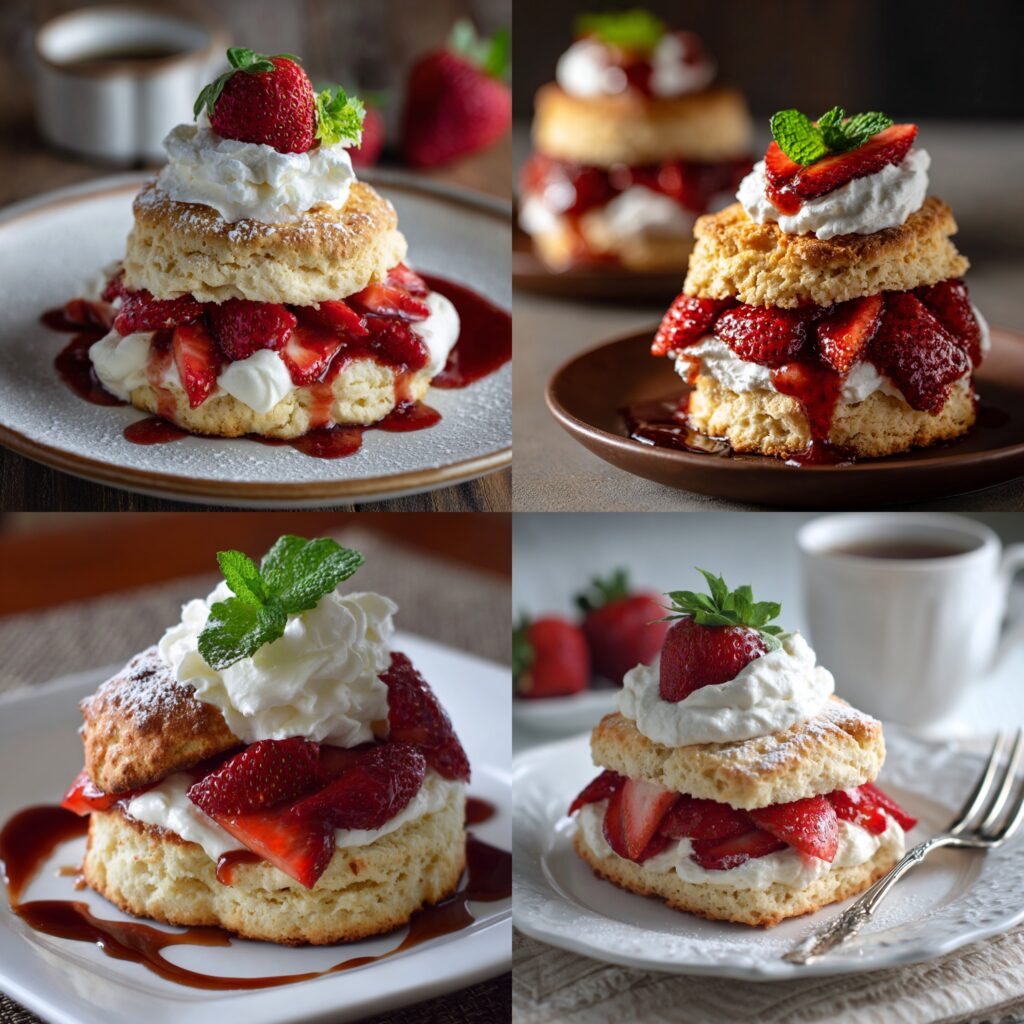
FAQs: Amish Shortcake Recipe
Frequently Asked Questions (FAQs)
What is an Amish Shortcake Recipe?
It’s a biscuit-style shortcake baked as a single slab, split and layered with juicy fruit and whipped cream—lightly sweet, tender, and sturdy enough to soak up fruit juices.
Can I use buttermilk instead of milk?
Yes. Buttermilk makes the crumb softer and slightly taller. Start with 3/4 cup and add more only if the dough looks dry.
How do I store leftovers and reheat?
Unfilled shortcake keeps wrapped at room temperature for 24 hours. Assembled leftovers hold 1–2 days in the fridge. Re-crisp slices at 300°F/150°C for 5–8 minutes.

